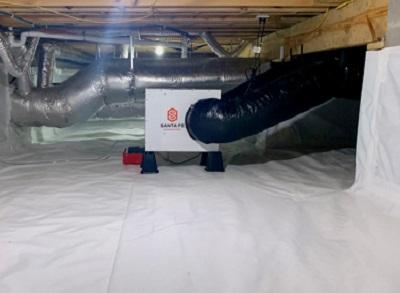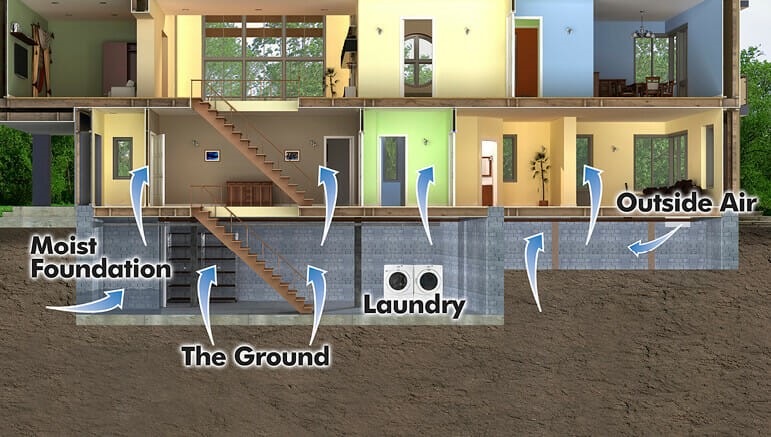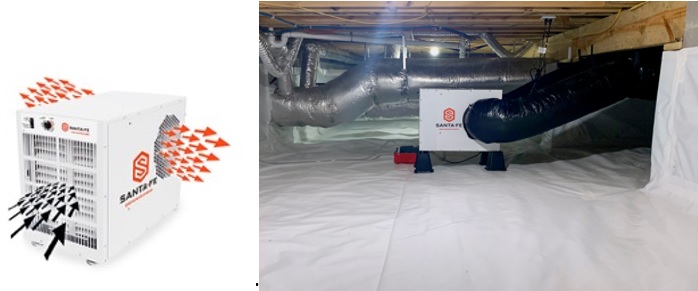
The crawl space is one of the most confusing and misunderstood areas of a home. If not treated properly, a crawl space can be detrimental to the:
- Structure of the home
- Health and comfort of the homeowners
- Home’s energy consumption
Crawl spaces are part of the home, even if it is out of sight, out of mind. It is also most likely the dirtiest, dampest, and smelliest room in the entire house. Plagued by high levels of moisture leading to mold, insect infestations, structural issues, and poor indoor air quality throughout the entire home.
In many parts of the country during the spring, summer and fall months, warm, moist air enters the vented crawl space from the outside and condenses on the cooler surfaces of the walls, floor and ductwork. This coupled with the moisture from the dirt ground and water leaking in through imperfections in the foundation walls has led to an epidemic of sick houses.
This excess moisture contributes to wood rot, mold growth, poor air quality, and increased pest activity, including infestation and colonization. Moisture in crawl spaces often migrates to the upper levels of the home through a “stack effect.” In essence, whatever air is below the house is also inside the house. As warm air rises and escapes through the upper levels of the home, new air finds its way into the home to replace what’s been lost. Intake air comes in at the lower levels — through unsealed crawl spaces. As a result, moisture levels can quickly elevate in the crawlspace. Once above 60% relative humidity the crawl space will attract more pests, grow mold, mildew, bacteria, and other biological allergens, leading to musty odors, and even foundation structural issues.

Pests
Pests are actually believed to cause more structural damage to homes each year than fires and storms combined. These unhealthy and damaging critters need water to survive. High humidity in the home not only provides them a life-sustaining water supply, but it’s also an invitation for further infestation and colonization.
Termites and wood-boring beetles thrive on moldy wood in damp crawlspaces with a moisture content of typically 20 percent or more. The estimated cost of repair by subterranean termites in the United States can exceed $2 billion annually. By offering crawl space encapsulation with dedicated dehumidification, pest control professionals can help their customers solve excess moisture issues and generate another source of revenue.

Health & Comfort
High humidity in homes has been scientifically documented to cause health related issues. Mold, bacteria, cockroaches, and dust mites have been linked to triggering allergies and asthma attacks and may even cause children who do not have allergies or asthma to develop either condition. Exposure can cause coughing, sneezing, wheezing, upper respiratory irritation and asthma symptoms. It is important to remember that polluted air in the crawlspace will make its way into the rest of the home often times carrying odors, contributing to poor indoor air quality and causing uncomfortably high humidity levels. In fact, studies show that as much as 50 percent of the air in a home comes from these below-grade areas.
Effects of Moisture on the Home
Excess moisture in the crawl space can cause mold to grow. Mold can grow in or on almost anything in the home, including furniture, carpet, wood, dry wall, and insulation. Too much moisture can also cause wood to buckle, split and even rot, which may weaken the structure of the home. It can even cause peeling, chipping or cracking of paint.
Signs of excess moisture in the home that may be coming from the crawl space:
- At 60 percent relative humidity for 72 straight hours can create mold, mildew, and fungus problems.
- At a relative humidity of 75 percent, wood floors will start to cup. Walls and ceilings will become stained.
- And at 85 percent relative humidity wood starts to rot and paint begins to blister.
The Solution
Building experts agree that in green grass climates homeowners should invest the additional effort to incorporate encapsulated space systems in both new and existing homes. The moisture control provided by a properly encapsulated space with a dehumidifier specifically designed for this application can dramatically reduce the risk associated liability of mold and pest damage.

Santa-Fe Dehumidifiers are specifically designed to operate in crawl spaces. These units will remove any excess humidity that can cause health and comfort issues in the entire home, as well as, making the crawl space inhospitable for fungi, dust mites, wood destroying insects, and other pests.
The Importance of Air Movement
A key factor to consider when choosing a dehumidifier is the amount of air movement needed to distribute dry air throughout the crawl space and basement.
Most free-standing dehumidifiers tend to recirculate the air immediately surrounding them, creating a zone of warm, lower-relative-humidity. This often leads to a dehumidifier prematurely shutting down its cooling cycle and then starting up again a short time later — not only is this inefficient, but it delivers poor moisture removal.

All Santa Fe dehumidifiers feature patented dual exhaust (except the smallest Compact70) specifically designed to provide the optimal amount of airflow in crawl spaces and basements. The powerful dual exhaust improves air circulation throughout the entire space, allowing the maximum amount of air to be treated in the shortest time. Dual exhaust dehumidifiers will offer a lot of versatility for any application.
Why Santa Fe Dehumidifiers?
Unmatched Warranty
Santa Fe offers warranties that are unmatched in the industry. No other manufacturer comes close to matching it. After all, when you build a quality product, you’re not afraid to stand behind it.
Energy Efficient
Many big box dehumidifiers are not energy efficient — and those that are barely make the cut. At Santa Fe, every dehumidifier we manufacture exceeds Department of Energy requirements. From the very beginning of development, we focus on building dehumidifiers that are second to none when it comes to performance, efficiency and longevity.
Superior Filtration
Equipped with MERV-13 filters, Santa Fe has the best filtration of any dehumidifier on the market. What does this mean? It means our dehumidifiers remove 98% of dust, compared to the MERV-8 filter, which only has 90% dust removal. Over a six-year period, our premium filter can remove up to 2 pounds of dust, pollen, mold spores, pet dander and bacteria from the air in your home.
For more information on Santa Fe’s complete line of crawl space and basement dehumidifiers, visit www.Santa-Fe-Products.com.

